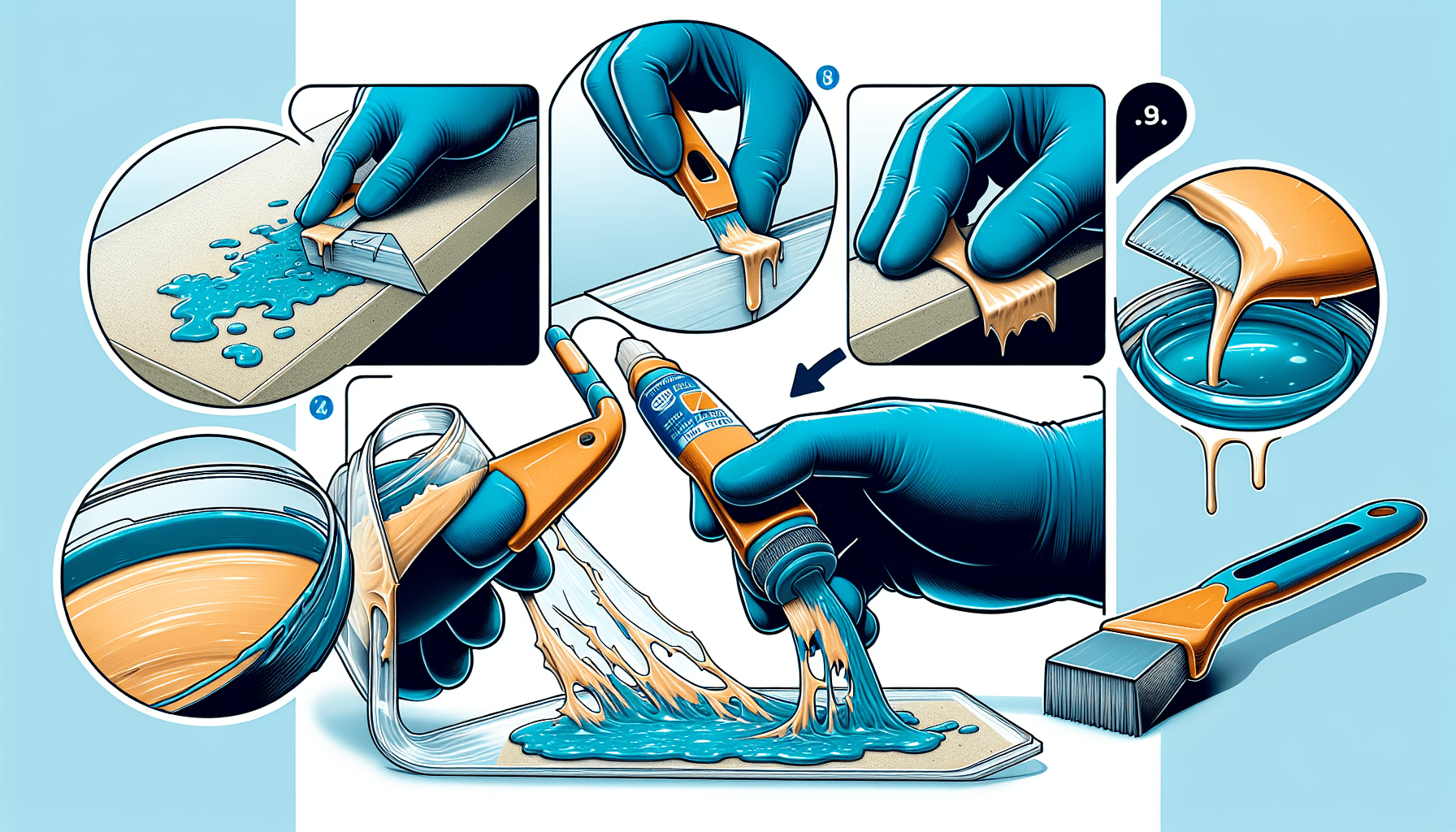Enamel paint can be a durable and glossy finish for plastic surfaces, but it can also be a challenge to remove when necessary. Whether you’re dealing with accidental spills, unwanted drips, or simply want to repaint a plastic object, knowing the proper techniques to remove enamel paint from plastic is crucial. In this article, you will discover effective methods and tips that will enable you to safely and efficiently remove enamel paint from plastic surfaces without causing any damage or leaving behind unsightly residue.
Preparation
Before you begin the process of removing enamel paint from plastic, it is important to gather all the necessary supplies. You will need gloves, protective eyewear, a respirator or mask, isopropyl alcohol, acetone, paint thinner, vinegar, baking soda, nail polish remover, WD-40, a magic eraser, a heat gun or hair dryer, and sandpaper or an abrasive pad. Having these items on hand will ensure that you are prepared for any method you choose to use.
In addition to gathering supplies, it is crucial to choose a well-ventilated area for this task. The fumes from the paint removal substances can be strong, so working in a space with proper ventilation will help to minimize any potential health hazards. If possible, it is recommended to work outside or in a well-ventilated room.
To protect your working surface, it is advisable to cover it with a cloth or plastic sheet. This will prevent any accidental spills or stains and make for easier cleanup later on.
Safety Precautions
When dealing with enamel paint and the chemicals used for its removal, it is essential to take proper safety precautions. Always wear gloves to protect your hands from any harmful substances. Additionally, wearing protective eyewear is crucial to shield your eyes from any potential splashes or fumes.
To protect your respiratory system, it is highly recommended to use a respirator or mask. These will filter out any harmful particles or fumes, ensuring your safety while working with paint removal substances.

Testing on a Small Area
Before proceeding with the full paint removal process, it is important to test the chosen method on a small, inconspicuous spot. This will allow you to observe how the plastic surface reacts to the paint removal method and ensure that it does not damage or discolor the plastic.
To test, choose a small area on the plastic surface that is not easily visible. Apply the chosen paint removal method to this spot and carefully observe the reaction. If the plastic surface remains unharmed, you can proceed confidently with the paint removal process.
Methods for Removing Enamel Paint
There are various methods that can be used to remove enamel paint from plastic. Each method has its own advantages and considerations. Here are some commonly used methods:
1. Using Isopropyl Alcohol
Isopropyl alcohol is an effective solvent that can help dissolve enamel paint from plastic surfaces. Apply the alcohol to the paint, and let it sit for a few minutes to allow it to work. Then, scrub the paint gently with a soft cloth or sponge. Repeat if necessary until the paint is completely removed.
2. Using Acetone
Acetone is another powerful solvent that can effectively remove enamel paint from plastic. Apply a small amount of acetone to the paint and let it sit for a few minutes. Then, use a soft cloth or sponge to gently scrub away the paint. Be cautious, as acetone can potentially damage certain types of plastic, so it is important to test it on a small area first.
3. Using Paint Thinner
Paint thinner is a commonly used product for removing paint from various surfaces, including plastic. Apply a small amount of paint thinner to the enamel paint on the plastic surface. Allow it to sit for a few minutes, then use a soft cloth or sponge to gently scrub off the paint. Repeat if necessary.
4. Using Vinegar
Vinegar can be an effective natural option for removing enamel paint from plastic. Apply vinegar directly to the paint and let it sit for a few minutes. Then, use a soft cloth or sponge to gently scrub away the paint. Repeat if necessary until the paint is completely removed.
5. Using Baking Soda
Baking soda can act as an abrasive to help remove enamel paint from plastic. Create a paste by mixing baking soda with water or vinegar. Apply the paste to the paint and let it sit for a few minutes. Then, use a soft cloth or sponge to gently scrub off the paint. Rinse the plastic surface thoroughly after removing the paint.
6. Using Nail Polish Remover
Nail polish remover, especially the acetone-based ones, can be effective in removing enamel paint from plastic. Apply the nail polish remover to the paint and let it sit for a few minutes. Then, use a soft cloth or sponge to gently scrub off the paint. Repeat if necessary.
7. Using WD-40
WD-40 is a versatile product that can also be used to remove enamel paint from plastic. Apply a small amount of WD-40 to the paint and let it sit for a few minutes. Then, use a soft cloth or sponge to gently scrub off the paint. Repeat if necessary until the paint is completely removed.
8. Using a Magic Eraser
A magic eraser is a handy tool that can effectively remove enamel paint from plastic surfaces. Wet the magic eraser and gently scrub the paint until it is removed. Be cautious not to scrub too hard, as it may damage the plastic surface.
9. Using a Heat Gun or Hair Dryer
Applying heat to the enamel paint can help loosen it from the plastic surface, making it easier to remove. Use a heat gun or hair dryer on a low setting to warm up the paint. Once warmed, use a soft cloth or sponge to gently scrub off the paint. Be careful not to use excessive heat as it can damage the plastic.
10. Using Sandpaper or Abrasive Pad
For stubborn enamel paint that is difficult to remove, sandpaper or an abrasive pad can be used. Gently sand or scrub the painted area until the paint is lifted from the plastic surface. Use caution and test the method on a small area first to avoid damaging the plastic.
Choose the method that best suits your needs and materials, keeping in mind the specific considerations and precautions for each.

Step-by-Step Instructions
After selecting the appropriate method based on your needs and conducting the initial test, follow these step-by-step instructions for removing enamel paint from plastic:
-
Apply the chosen method: Ensure that you have all the necessary supplies ready and begin by applying the chosen paint removal method to the affected area.
-
Let the substance sit on the paint: Allow the chosen substance to sit on the enamel paint for the recommended amount of time specified by the product instructions. This will ensure maximum effectiveness in dissolving the paint.
-
Use a soft cloth or sponge to scrub gently: Once the paint has had time to react with the chosen substance, use a soft cloth or sponge to gently scrub the paint in circular motions. Be careful not to scrub too hard, as this may damage the plastic.
-
Repeat if necessary: If there is still some paint residue left on the plastic surface, repeat the process until the paint is completely removed. It may require multiple attempts, depending on the thickness and type of enamel paint.
-
Wipe the surface with a clean cloth: After successfully removing the enamel paint, use a clean cloth to wipe away any remaining residue or excess paint removal substance.
-
Clean the plastic with mild soap and water: To ensure that no traces of paint or paint removal substances are left behind, clean the plastic surface with mild soap and water. This will help restore the plastic to its original state.
-
Dry the plastic thoroughly: Finally, dry the plastic surface thoroughly with a clean cloth or allow it to air dry completely. This step is crucial to prevent any potential damage or discoloration.
Additional Tips
Here are some additional tips to consider when removing enamel paint from plastic:
-
Use a plastic scraper or old toothbrush for stubborn paint: If the enamel paint is particularly stubborn, a plastic scraper or an old toothbrush can be used to gently scrape or brush it away. Be careful not to use any sharp tools that may scratch or damage the plastic surface.
-
Avoid using harsh chemicals on sensitive or colored plastics: Some plastics may be sensitive to certain chemicals, so it is essential to avoid using harsh chemicals that can cause damage or discoloration. Always test the chosen method on a small, inconspicuous area first.
-
Consider using a plastic-safe paint remover: If you are unsure about which method to use, consider using a paint remover specifically formulated for use on plastic surfaces. These products are designed to remove paint without damaging the plastic itself.
-
Consult the manufacturer’s instructions for specific plastic types: Different types of plastic may react differently to paint removal methods. It is advisable to consult the manufacturer’s instructions for the specific type of plastic you are dealing with to ensure compatibility and prevent any damage.
-
Test a hidden area first if attempting to remove paint from a valuable or delicate item: If you are attempting to remove paint from a valuable or delicate plastic item, it is strongly recommended to test the method on a hidden or less noticeable area first. This will help ensure that the process does not negatively affect the item’s value or appearance.
Maintenance and Prevention
To keep plastic surfaces looking their best and prevent future paint-related issues, here are some maintenance and prevention tips:
-
Clean plastic surfaces regularly: Regular cleaning of plastic surfaces can prevent the accumulation of dirt, dust, and stains, making them easier to maintain in the long run. Use mild soap and water to clean the plastic, and avoid using abrasive cleaners that can scratch the surface.
-
Store painted items properly: If you have painted plastic items, it is important to store them properly to minimize the risk of paint damage. Avoid exposing painted plastic to extreme temperatures or sunlight, as these can cause the paint to fade or peel.
-
Consider applying a protective sealant on plastic surfaces: Applying a protective sealant can help prevent future paint-related issues on plastic surfaces. There are various sealants available specifically designed for use on plastic, which can help enhance durability and longevity.
-
Use painter’s tape or protect the surrounding areas when painting plastic: When painting plastic objects, it is crucial to protect the surrounding areas to prevent unwanted paint transfer or spills. Use painter’s tape or cover nearby surfaces with plastic sheets to create a barrier and ensure clean paint lines.
When to Seek Professional Help
While removing enamel paint from plastic is a task that can often be accomplished DIY-style, there may be instances when professional help is warranted. Here are some situations where seeking professional assistance is recommended:
-
If the paint does not come off after trying multiple methods: If you have tried multiple methods and the enamel paint is still not coming off, it may be best to seek professional help. Professional painters or restoration experts have specialized knowledge and tools to deal with stubborn paint that cannot be easily removed.
-
For valuable or delicate plastic items: If you are dealing with valuable or delicate plastic items, it is highly advisable to consult a professional before attempting any paint removal process. They can provide expert advice and services tailored to the specific needs of your item.
-
If the paint removal process damages the plastic surface: If the paint removal process ends up causing damage to the plastic surface, it is essential to seek professional assistance to repair or restore the plastic. Professionals have the expertise to address any damage that may have occurred during the paint removal process.
Conclusion
Removing enamel paint from plastic can be achieved with various methods, each with its own advantages and considerations. By following the proper precautions and instructions outlined in this article, you can effectively restore the plastic’s original appearance. Remember to select the appropriate method, conduct a small test, and take necessary safety precautions throughout the process. With patience and care, you can successfully remove enamel paint from plastic and enjoy clean and pristine plastic surfaces once again.



